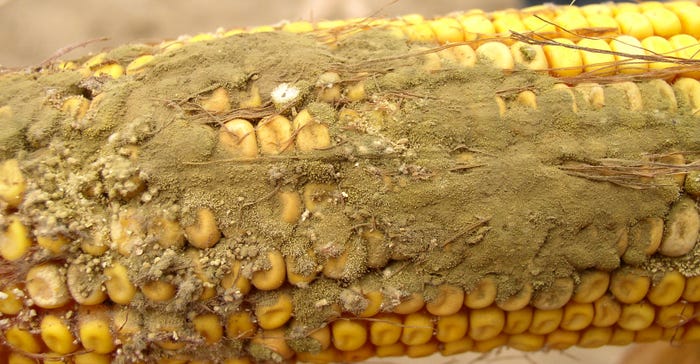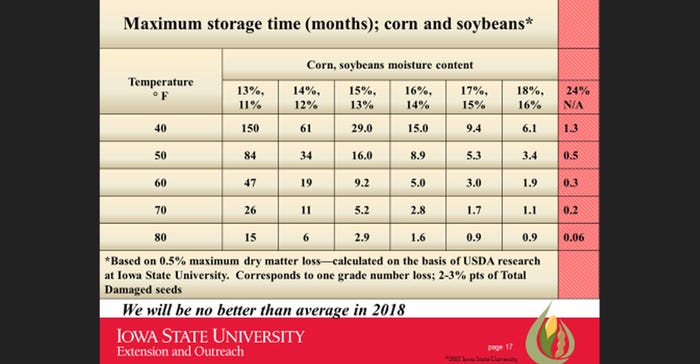
Wet conditions have added a new issue to the 2018 harvest. “It’s been a difficult harvest this fall, and now we’re going to have mold problems in fields for sure,” says Charlie Hurburgh, Iowa State University Extension grain quality specialist. On Oct. 8, another rainy day, he was urging farmers to scout their cornfields to see which ones are more affected by ear mold and to harvest those fields first.
This year continues the chain of years with unusual harvest conditions driven by rapid weather changes in the latter part of the growing season. In mid-August, crops were maturing well ahead of schedule. Heat and moisture in May and June accelerated the pace of development, to the point that signs of maturity in some fields were evident by mid-August.
Rains followed by above-average temperatures began over Labor Day weekend and have been repeated nearly every weekend to date. Weather in much of Iowa over the Oct. 7 weekend brought more of the same — heavy rains with intermittent warm, sunny and high-humidity periods.
“The 2018 crop is now at a point where the wet conditions are affecting grain quality,” Hurburgh says.
In some areas, flooded streams inundated mature crops. He suggests farmers read this ICM News article, “Management of flood submerged grain,” written to provide guidance in handling these crops.
Mold showing up in cornfields
Corn moisture content varies widely, but field mold is showing up. Most field molds grow on corn after the crop reaches black layer stage; rapid drydown normally prevents significant further problems.
“Fields should be scouted for molds because some species have the potential to produce mycotoxins,” Hurburgh says. “Those fields should be harvested as quickly as possible and dried rapidly, without a long period of wet grain holding.”
Field molds normally do not grow on grain in storage after the grain has been drying, but wet holding and slow drying can cause growth and toxin increases before the corn is dry. The lower-temperature and air-drying systems will have difficulty in wet weather.
“Run bin dryers as warm as the manufacturer’s recommendations allow, and try to fill bins in stages to reduce depth and increase drying rates in individual bins,” he advises.
Rotating the fills among bins may require documentation for crop insurance purposes, to identify grain traceable to specific fields. Hurburgh, along with ISU Extension plant pathologist Alison Robertson, provide the following information.
Information on molds and mycotoxins
Descriptions and photos of field molds, mycotoxins and their impacts are available at cropprotectionnetwork.org/library, in the training modules section.
• CPN-2001 Corn ear rots
• CPN 2002 Corn mycotoxin FAQs
• CPN 2003 Corn grain sampling and mycotoxin testing
• CPN 2004 Storing mycotoxin-affected grain
A two-part narrated presentation on mycotoxin effects on animals, and on handling and management for toxin-affected grain is on the Iowa Grain Quality Initiative website.
A recommended scouting and sampling procedure for mold identification is:
• Check at least 100 ears selected from throughout the field.
• If more than 10% of plants have an ear rot, harvest the field early.
• Dry and cool harvested corn quickly.
• Test moldy grain for mycotoxins before feeding to livestock
This year, the highest risks for mycotoxins are for vomitoxin (DON) in northern and southwest Iowa, and for some aflatoxin in southeast Iowa (where drought conditions prevailed until after Labor Day).
The longer the wet weather persists, the more risk of mold and toxins. The moderately warm temperatures forecast for the next 10 days will accentuate mold growth. Moldy grain doesn’t automatically contain mycotoxins; some species are not toxigenic, and not all toxigenic species always produce toxins. That’s why end users (ethanol plants, feed mills, wet mills) screen composite samples of early harvest corn deliveries to determine if there are concerns.
The often-present “polka dots” from Cladosporium are an example of field mold that will grade damaged, but it does not produce a toxin.
Check for stalk strength
Stalk strength is low; there will be increasing amounts of downed or broken stalks. The ISU specialists advise farmers to harvest fields of downed corn first, regardless of moisture content, because mold growth is accelerated, and grain drydown rates are reduced.
Consider cleaning this corn, if possible, because the larger mass of material through the combine will create more airflow-clogging fines and foreign material, Hurburgh says. It’s always recommended to remove the grain from the center of bins before long-term storage. That need will be greater than usual this year.
Corn quality average at best
General corn quality is average at best this year, as indicated by test weights. Kernel fill wasn’t as complete as last year; dry corn test weights probably will be 54 to 56 pounds per bushel. This still meets grade standards, but you can expect a shorter storage life than last year. Because of reduced fill and kernel size, protein content will likely be below the 7.5% long-term average.
The critical management actions this year will be to rapidly dry the grain without long holding periods and cool it as quickly as possible to preserve future storage life. Actions now, at harvesttime, are the most crucial in determining future quality of the stored grain the following spring and summer.
The table below shows the time-moisture-and-temperature relationship for safe storage.

Both temperature and moisture content are important in grain preservation, but often temperature control is the most immediately important if drying capacity is limited.
Beans have less mold
Soybeans have fewer in-field mold problems than corn because moisture content of beans is normally low (less than 13%). However, if the soak-dry cycles continue with more heavy rain, you can expect to see pod splitting and eventually gray-colored beans. Freeze-thaw cycles would further accentuate the splitting, but currently there are no forecasts for frost soon.
Do not try to store field-molded soybeans; the oil will become rancid, and continued deterioration is likely. The gray beans will grade “damaged” in the market, but likely will get worse in storage. Aerate them for cooling, and then market them as soon as possible.
The same needs for removing the center core of grain in bins and dropping the temperature of grain as rapidly as possible apply to soybeans as corn. Notice in the storage time table accompanying this article that soybeans spoil at a rate equal to 2% wetter corn. Soybeans are normally 13% to 14% moisture or less in the field.
Special handing
Soybeans are often stored in unaerated bins or buildings; this removes both the cooling and drying capability of aerated bins. Wet fields and warm temperatures may require special handling to be sure beans in unaerated bins are cool and dry.
None of these wet condition problems affect grain yield — that was established earlier in the growing season. The predicted high yields and corresponding long-term storage will make at-harvest management very important this year. Future articles on ISU’s long-term website will update these issues and identify long-term storage management needs as weather conditions develop.
To see photos of corn mold, click through the slideshow below.
About the Author(s)
You May Also Like




